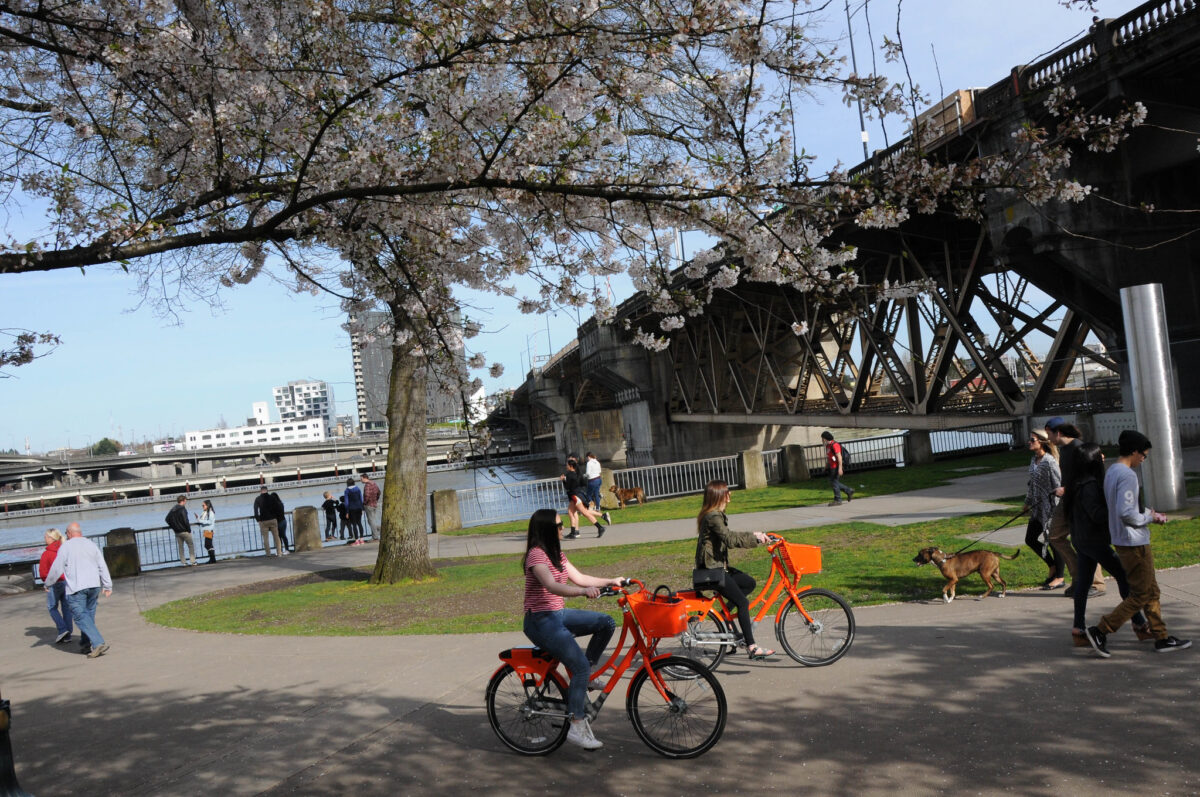
(Photo: J. Maus/BikePortland)
In news that won’t surprise anyone that’s been following along closely, the Portland Bureau of Transportation announced at a city council meeting yesterday that their planned bike share expansion will include electric bikes and cover more parts of the city.
“We’re really excited about the electric bicycle piece of this… We think it will really make a difference.”
— Steve Hoyt-McBeth, Biketown program manager
The first official confirmation of the upgrade came from Biketown Program Manager Steve Hoyt-McBeth. He was at council to ask commissioners for an extension of the city’s current contract with Motivate, Inc., the company that operates the Biketown bike share system.
During his short presentation, Hoyt-McBeth said the city plans to release a request for proposals this summer that would, “Expand Biketown into new neighborhoods, and hopefully include the entire city and that will include electric bicycles.” The new system isn’t expected to be up and running until spring of next year (2020).
Electric motors on bike share bikes available in every corner of the city would be a game-changer. Housing prices have forced many Portlanders to live further than ever from jobs and other destinations and access to a relatively cheap, reliable, fun, efficient (no traffic!), bicycle could vastly increase the viability and the appeal of bicycling. A survey taken last year revealed that more than a third of Biketown members said they’d use the service more often if the e-bikes were available.
The ultimate size and geographic scope of the upcoming bike share expansion will depend in part on what vendors offer in response to the RFP. But Hoyt-McBeth made it clear in his language yesterday that expanding the system to places like east and southwest Portland with e-bikes is a foregone conclusion. “We’re really excited about the electric bicycle piece of this,” Hoyt-McBeth said, “We think it will really make a difference — not only for people in general in making biking and bike share more attractive to more people — but also from an equity perspective as we move this system out into east Portland and other areas… hopefully into southwest as well. And with the hills, having an electric bike will really make biking more viable for people.”
If you haven’t noticed, e-bikes are beginning to proliferate on Portland’s bikeways. And if you’ve ridden one, you know first-hand how life-changing they can be. Having power-assist means people can ride further, faster, and carry more stuff without getting as tired. It opens up the idea of cycling to a much broader swath of the population and it allows existing riders to ride even more.
Portlanders got a taste of electric bike share last summer when Jump and Lime offered motorized bikes during a closure of the Portland Aerial Tram.
Last fall, Portland hosted a bike share conference where Ryan Rzepecki, the founder and CEO of Jump, a leading electric bike share company, confirmed to me he was already in talks with PBOT. In his keynote speech, Rzepecki sang the praises of “light electric mobility” and said, “Regular pedal bikes never showed the type of growth and traction as you’re seeing with electric vehicles. The amount of people interested in riding e-bikes or e-scooters is much higher than folks riding a pedal bike because this is mostly about transportation and not recreation or exercise. It’s about getting where you’re going quickly, conveniently, without breaking a sweat. And electric mobility offers that in a way that pedal bikes don’t.”
Biketown’s current system has 1,002 (relatively heavy and slow) non-electric bikes strewn across 147 stations. The city’s contract with Motivate is set to expire on August 1st, 2019. Yesterday PBOT asked council to support an ordinance (PDF) that would extend the existing contract and allow them to increase the value of it by $3.4 million so they could continue to pay Motivate through April 30th, 2020. As per city council demands when the bike share program was established in 2013, Biketown doesn’t use any public funds (beyond Hoyt-McBeth’s staff time, which is paid via general transportation revenue that comes from gas taxes, parking revenue, and so on). PBOT pays Motivate for operation of the system solely through user fees and sponsorship revenue from Nike and Kaiser Permanente.
Advertisement
All commissioners present yesterday were strongly in favor of the ordinance and it passed 4-0 (Mayor Ted Wheeler was absent).
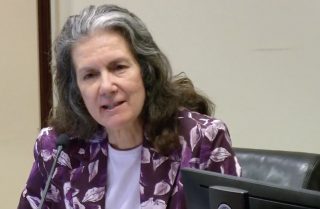
The only minor quibble with Biketown came from Commissioner Amanda Fritz.
Just as she did when the bike share plan was first passed in 2015, Commissioner Fritz expressed concerns that Biketown users don’t have easy access to city-provided helmets. “Have we made progress on the helmet issue?” she asked Hoyt-McBeth. “We have not made progress on having something available in real-time,” he replied. Hoyt-McBeth explained that a company PBOT was in discussions with to provide helmets at their kiosks went bankrupt and they have yet to see anyone else enter the market. “When we come back with the new RFP,” he added, “That will be an opportunity to see if there are other solutions out there.”
Commissioner Fritz also used the occasion of yesterday’s meeting to remind people that riding bikes and scooters on sidewalks downtown is not allowed. “People say this is the reason we can’t have nice things. If people continue to break the rules then there will be a problem and they will no longer be able to have the nice things of the bikes and the scooters; because it’s all about shared space and safety.”
Lest you think Commissioner Fritz is anything but a fan of Biketown, she offered Hoyt-McBeth congratulations prior to her “yes” vote. She noted there was zero controversy with Biketown and that the program has been a huge success. “I think it’s definitely a good thing that it has become less controversial and has become more of a way of life.”
And by next summer bike share will be an even larger part of our lives.
— Jonathan Maus: (503) 706-8804, @jonathan_maus on Twitter and jonathan@bikeportland.org
Never miss a story. Sign-up for the daily BP Headlines email.
BikePortland needs your support.


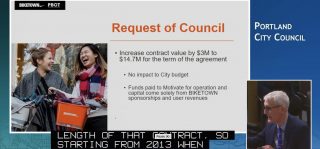
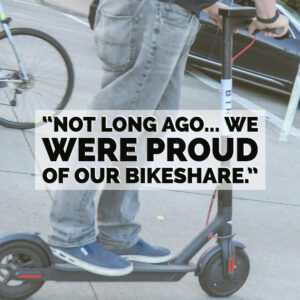
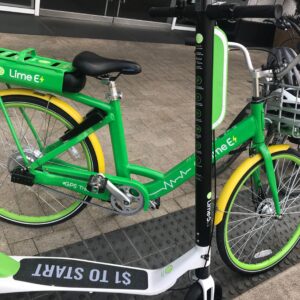
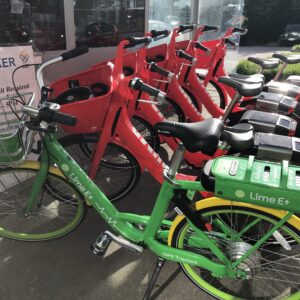
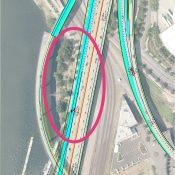
Thanks for reading.
BikePortland has served this community with independent community journalism since 2005. We rely on subscriptions from readers like you to survive. Your financial support is vital in keeping this valuable resource alive and well.
Please subscribe today to strengthen and expand our work.
They are mopeds. Bicycles do not have motors. Rebrand it all you want…
K.
An electric bicycle still requires you to pedal and you can still expend a decent amount of effort on one. The only difference is you can go twice as fast and twice as far which is a real benefit to those of us with long commutes who would otherwise be in a car. If we want to get serious about moving away from a car centered transportation system then we need to encourage all forms of clean alternative transportation. Ebikes and (electric) mopeds included.
So did the first mopeds? “motorized with pedals”
The name and real definition, there’s no difference. With a large quantity of ebikes, you can still use throttle-only under 20mph – no pedaling required.
>>> Housing prices have forced many Portlanders to live further than ever from jobs and other destinations <<<
I know this is part of The Narrative, but is it actually true that a higher proportion of Portlanders now live further from their jobs and destinations than, say, 10 or 20 years ago? If anything, with all the new apartments in inner Portland, the center of mass has moved inward. Perhaps more accurate would be to say "New housing has allowed Portlanders to move closer to their jobs and destinations."
The sentence you quote says “many Portlanders” but you proceeded to make an argument about whether it is true that “a higher proportion of Portlanders” now live further. You can’t logically jump from “many” to “higher proportion”. Those two are two different concepts.
True, but in context it suggests the problem is getting worse, while in reality I contend it is not. A statement can be technically accurate and still be misleading.
Well based on census data the mean travel time to work in 2005 was 23.2 minutes and is 27 minutes for 2017.
https://factfinder.census.gov/faces/tableservices/jsf/pages/productview.xhtml?pid=ACS_17_1YR_S0801&prodType=table
With congestion worsening rapidly, time does not correlate well with distance. If anything, such a small increase seems to support my contention. Thanks for posting it!
Well I’m not sure we could say either way where that extra time comes from but when you’re talking averages 4 minutes is a lot.
“is it actually true that a higher proportion of Portlanders now live further from their jobs and destinations than, say, 10 or 20 years ago?”
A higher portion of established lower income residence yes. More established lower income residence moved further out and were replaced by newer wealthier residence. The fact that total inner city population remains high does not compensate for the fact that lower income residence were displaced. I think they are trying to say to that moving to a wider bike share region may compensate for some small part of this involuntary displacement of lower income residence to more remote locations.
Probably all true.
It is now, as it has always been, the case that those with less money tend to live in the less desirable areas. Our definition of “less desirable” changes over time; not so long ago, the center of our cities were relegated to the poor and those without options. Before that, it was the outskirts. This will likely change yet again in the future, once the pendulum swings back.
Apologies in advance… I work a long day at an unpleasant job, and hate continuing to have to translate when I get home. “Residents,” not “residence.”
I don’t want to criticize Fritz too harshly, because she did vote for CCIM, but the solution to sidewalk riding is to provide a safe place for people to ride. There is a huge segment of the population that will not take the lane on SW 4th Ave, but would ride in the (hopefully high quality) protected bike lane we’re going to build on SW 4th.
Whether you feel safe taking the lane or not, it is not appropriate to be riding bikes on the sidewalk along SW 4th. Can we all agree to that?
My point is that sidewalk riding is a symptom of failure, to date, to build any kind of bike network in downtown. Hopefully that will be changing soon.
Ironically, the center vehicle lane is probably the safest place to ride downtown (perhaps excepting the green lanes on Oak and Washington), and I include in that the “protected” bike lane along 2nd.
Sometimes less is more.
I think you mean SW Oak and SW Harvey Milk, FKA Stark St. For once in a while, we agree. Bike lanes on nearly-flat streets, or downhills = fewer lanes for bike riders. Also, conflicts from people in motor vehicles turning across bike lanes. Motor vehicles being unloaded in “my” lane. Lanes that are closed seemingly interminably when there is a construction project. Big piles of snow. Etc.
If we’re going to spend money on alternative infrastructure, make mine a woonerf, or a superblock. For an example of what not do, take SW 2nd Ave. Please.
“Biketown’s current system has 1,002 (relatively heavy and slow) non-electric bikes strewn across 147 stations” …and also strewn on the sidewalk, and parked in the limited number of bike racks available for bikes that are not orange?
If we’re going to add a new and attractive category of bikeshare bikes could we please, please! give a fee premium to users who park them in the orange racks built in public space? And why not have some superstations that offer charging and customer support? They would be an attraction for tourists, groups renting multiple bikes, and people using bikes recreationally.
I’m ambivalent about scooters but I’d like them better if they would inhabit “scooter spots” set aside in places that are NOT bike racks. A fee premium for proper parking would reduce clutter, simplify charging, and make it easier to use them.
Nope. If a person feels safer riding at a slow speed on a sidewalk rather than dodging a few thousand pounds of metal and plastic (operated by increasingly distracted drivers), I say more power to them.
Down with pedestrians!
(or walk your bike)
Or, you know, bike at walking speed, which I do often.
No, because it does nothing to address the issue of people not feeling safe to ride where they should be riding.
making the user downstream feel unsafe does no good.
If you don’t feel safe riding in the street, that does not mean that you should make it unsafe for people walking.
Bikes on the sidewalk are much like the cars that you are trying to get away from. Only problem is that there is no place for the pedestrian to get away from you. Just don’t do it.
4th? I’m an older fella, no spring chicken (you can tell because I use terms like “fella” and “spring chicken”), and I have zero problems taking the lane on 4th. I’m going to do it in about an hour. It is pretty much one-way downhill, making it super easy to keep up with traffic, even without an e-bike. These are (IMO), the kind of streets least in need of specialized protection. It makes sense on Broadway (although it was implemented horrendously) because that is largely uphill. It makes sense on Naito, even though it’s next to a park, because traffic speeds are higher on the street, and the paths through the park are dangerous in their own way. I remember when the Everett buffered bike lanes were added, and it was the same deal; one-way, downhill. Conventional bikes can coast their way to match the speed of traffic on such streets; why do we focus on putting “protected” infrastructure in these places?
Not to be a curmudgeon, but I’m a curmudgeon.
In the first image… The girl in the foreground… Is it me, or does she look at first glance like a 3D cartoon image of some Shaggy (Scooby Doo) or 2D (Gorillaz) like character? On facebook I had to do a double take.
The two people behind her make up the face, neck, and ear (wearing a blue hat, with a white “blaze”, in a Yehuda Moon-like manner).
I think it’s just you.
Correction… There’s 3 people behind her. Two people jogging (count the legs), and the guy in the white shirt, who is standing.
It will be interesting to see what the uptake of bike-share will be like in SW Portland. I am personally dubious that it will work in this corner of Portland, and I predict the bike-share companies will rip out their stations in SW after they discover use is low.
I know SW residents take a lot of crap for driving everywhere, but look at our situation:
– Car2Go and other car-share services won’t serve SW Portland (except for PCC Sylvania, which is isolated and inconvenient and defeats the whole purpose of car-share);
– Other car-share companies have scaled back here;
– SW is very poorly served by Trimet, with routes that provide sparse coverage and run on infrequent schedules;
– Geographical barriers (serious hills) combined with a lack of cycling infrastructure, and even where we have infrastructure there are major obstacles such as the disappearing bike lanes on Barbur and 99W, the hostility of the Riverside Cemetery to cyclists, etc.
One might argue that residents of SW Portland are incentivized to drive everywhere. I’m not saying bike-share can’t work out here – bring it on. But I’d say the odds are stacked against it.
I just used a Jump (Uber) ebike in Washington DC last week, so here’s what they offer. It’s a step-through frame with a quick release seatpost, three gears with twist grip shifter, one power assist level, no throttle, front wheel hub motor, front basket. Basically, you are required to pedal, and power assist is always on. The built-in lock can be unlocked by the Jump smartphone app, and it does not require a return to a docking station. It does allow GPS- defined return zones, so that you are only allowed to end your rental session within designated geographies. The motor was strong enough that you could slowly climb a moderate hill while seated. No speedometer, so I’m not sure what was its top speed, but it felt like 20mph. This type of ebike would fit in well with Portland.
I have no dog in the helmet/no helmet fight, but folks can look to Vancouver, BC’s Mobi bike share program to see how bike share works with a mandatory helmet law. The design is pretty basic–each bike has its own helmet that connected to retractable cord that locks into the handle bar– and if you don’t want to wear the helmet you can just put it in the front basket (helmet liners are provided at stations). I don’t understand why the e-scooter companies can’t figure such a design out, but that’s a whole other thing…
Photos and such can be found here: https://www.bikeshare.com/news/spotlight-vancouver-mobi-shaw-go-bikeshare/
I hope that the e-bikes have more than one level of assist. I recently rode some Jump bikes in Santa Cruz, California. They have a fixed level, and it is very aggressive. Even going up some of the steepest hills in the area in the highest gear, I was rarely able to feel like I was doing much. And I was going at a speed that seemed a little uncomfortable (and I am a very experienced rider). Or at least keep some of the non-assisted bikes in the system for those of us who prefer it.
Sweet. The e-assist makes the heavy bikes way more useful and accessible. I vote for a 15mph governor for the sake of public safety, though.
“Regular pedal bikes never showed the type of growth and traction as you’re seeing with electric vehicles. The amount of people interested in riding e-bikes or e-scooters is much higher than folks riding a pedal bike because this is mostly about transportation and not recreation or exercise. It’s about getting where you’re going quickly, conveniently, without breaking a sweat. And electric mobility offers that in a way that pedal bikes don’t.”
Let’s not forget who is saying this, and also pause to note that most people have always been tempted by what Amory Lovins called ‘energy slaves.’ This is not terribly surprising and I’m not sure how wise it is to base our policy decisions on this kind of consumer vote. Though of course we are used to making policy in precisely this manner.
#IvanIllich
If you don’t give people options they want to choose (i.e.”consumer vote”), how do you motivate change?
It’s the old prerences vs constaints.
Preferences are fun, great as long as we (our appetites) are in charge, and there are no constraints discouraging the euphoric (capitalist) pursuit of convenience. Our policies (and the framing here exemplifies this) proceed as if constraints have no meaning, do not concern us.
Your ‘motivate change’ likewise proceeds from this premise: if it feels good, do it. But we don’t live in a world any more where our appetites usefully suggest where policy should take us. We would instead do well to get out in front of this, accept that just because it is fun, feels good, flatters our tastes, is convenient doesn’t mean we can (still) afford to make policy on these values, can have it all.
Given the lack of external constraints on people’s choices at the moment, the alternative to making people want to change is to have the government impose artificial constraints. That’s another way of saying forcing people. The third option available is, I suppose, that there be no change.
In a democracy, forcing people to do things they don’t want to do is hard (see the reaction to the very mild HB 2020 in Salem, for example). You talk a lot about “constraints” but very little about what those might look like, or how they might be imposed. External constraints will come, but by then they won’t matter.
In the meantime, getting people to voluntarily adopt change seems like the best option we’ve got.
“You talk a lot about “constraints” but very little about what those might look like, or how they might be imposed. External constraints will come, but by then they won’t matter.”
And you gloss over the fact that the constraints bearing down on us could be interpreted as guideposts, could lead to decisions, framings, prioritizations that look very different from what a focus on the goodies, the convenience would lead us to. This isn’t about imposing anything, but rather about ceasing to pretend that all of this has no besring on our lives. The market is hardly the only or even an adequate way to organize our lives. But you seem entirely unwilling to grant that.
Your gobbledegook is amazing…
Why don’t you just say what you want to say… You think that constraints are going to come but never say what you want to do really, except post stuff like this….
What is your opinion? What do you think the solutions are? Seriously!!!!
What is my opinion?
That we are in for a rough ride unless we scale back (figure out how to scale back) our appetites for fossil fuels by 90% in the medium term, and 100% soon after*. It is both necessary and possible but it won’t be easy. Since this blog is about transportation, figuring out how to phase oit our reliance, dependence on the automobile should be the top priority. I have not been shy about articulating this, so maybe you just haven’t been here very long?
* individual acts are important, but support from our government (no more spending on roads that only or chiefly serve the automobile, no more planning for continued automobility, and a reprioritization around climate neutral modes) is as important or maybe more so.
“That we are in for a rough ride unless we scale back (figure out how to scale back) our appetites for fossil fuels by 90% in the medium term, and 100% soon after*.”
An incredibly strong and authoritative statement that is made without a citation or any evidence other than your opinion.
A recent study in Nature Geosciences argued that long-term decarbonization will require “unprecedented scale of renewable energy” as well as “undemonstrated amounts of carbon capture”.
This study echoes an emerging consensus in the climate science literature (that has been, if anything, overly conservative in its modeling). What’s fascinating to me is that progressives and leftists are denying this modeling because they prefer to live in a fantasy world where modest changes (e.g. “degrowth” and “energy transitions”) will be enough to avoid a “rough ride”. As figure 3a of Millar et al shows, we are already in for a “rough ride”.
https://www.nature.com/ngeo/journal/vaop/ncurrent/full/ngeo3031.html
It probably doesn’t matter because we can’t even seem to get many basic, moderate steps done.
IMO, it’s worse that just an inability to get moderate things done. Many progressives and leftists oppose moderate mitigation proposals for the worst possible reason — the belief that because we export much of our CO2e elsewhere it’s up to *those people* to decarbonize, not us — never us. Thus, progressives are happy to protest “exporters” or “producers” but are mostly silent when it comes to our collective consumption. Our collective consumption of fossil fuels is the “third rail” of climate activism.
I know you hate it, but a carbon tax solves the “exporting it” problem; the cost of carbon emitted anywhere would be embedded into a product or service, so the only exporting that would make sense (from an emissions tax standpoint) would be to places like Iceland that get their energy from more sustainable sources than, say, China does.
I’ve never claimed the market is perfect, only that it’s our only choice. If you think you know a way to get us to impose constraints on ourselves, please tell someone in Salem. Or the city. Or the federal government.
In the meantime, I’ll cheer on everyone who is working on market based solutions to our environmental problems.
“only that it’s our only choice…”
You, and Margaret Thatcher. https://en.m.wikipedia.org/wiki/There_is_no_alternative
We should think about who is offering “The Choices”. Who gets to print the menu? We’re all eating at the Four Seasons like it’s McDonald’s, and putting it on our collective credit card. The restaurant owner (Mr. Market) is all-too-happy to let this continue, much to his benefit, until even the credit-rich max out their limit and have to start paying the bill. It does indeed appear that the only way to quit racking up the debt is to quit now and start cooking for ourselves, but as you point out, the ways in which we might “entice” people to do that are distinctly un-American. Perhaps The Government should think ahead to the next Great Depression and realize it will last indefinitely, not just for ten years. Then again, perhaps our “government” has already planned ahead and has amassed personal stockpiles in fortified compounds for himself.
There are at least two menus: there’s the one printed by the government (i.e. the people we elect to represent us), and there’s one printed by those offering new products/services that we may choose to use. Those menus have overlaps and lots of interaction, and, in the end, we’re going to need both to offer us something nourishing.
On your point about secret bunkers, that’s unlikely, because, unlike a sudden cataclysm, like a nuclear attack, this crisis has no endpoint. It’s not like someone can hunker down with their cache of food until the radiation levels drop and come out and rebuild the world. If you entered your bunker when the bread basket that is now the Sahara became a desert to wait it out, you’d still be down there.
“On your point about secret bunkers, that’s unlikely…”
Well, it is just a metaphor, but there are ways to ensure one will last a bit longer than the hoi-polloi if one has enough power and money, assuming money will be worth anything. I’m also conflating “The Government” with “The Rich” cuz, when’s the last time a non-wealthy person got elected to government?
“There are at least two menus: there’s the one printed by the government…and there’s one printed by those offering new products/services that we may choose to use.”
True enough, but when the government offers us this, while the Four Seasons offers, e.g., this, what are the majority of Americans going to “choose”, if they have substantial credit cards? (still a metaphor).